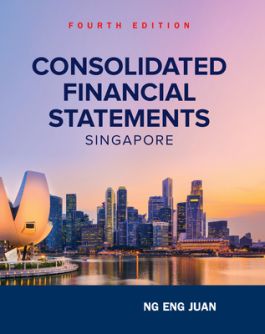Consolidated Financial Statements, 4th Edition
Preface
Preface to the First Edition
The Author
Table of Statutes, Financial Reporting Standards and Abbreviations
Chapter 1 Introduction
1.1 What are consolidated financial statements?
1.2 The applicable accounting standards
1.3 Who has to present consolidated financial statements?
1.4 Consolidation procedures
1.5 Usefulness and limitations of consolidated financial statements
1.6 Approaches adopted in this book.
Appendix 1A: Concept of ‘control’
Chapter 2 Consolidation at the Date of Acquisition
2.1 Introduction
2.2 Combination of accounts
2.3 Fair value adjustments (Purchase price allocation)
2.4 Goodwill on consolidation
2.5 Non-controlling interest
2.6 Summary
Problems for self-study
Chapter 3 Consolidation Subsequent to the Date of Acquisition
3.1Introduction
3.2 Consolidated statement of comprehensive income
3.3Pre-acquisition and post-acquisition reserves
3.4 Intragroup account balances
3.5 Unrealised intragroup profits and losses
3.6 Intragroup dividend
3.7 Other consolidation adjustments
3.8 Transition from FRS 27 (2009) and INT FRS 12 to FRS 110
3.9 Summary
Appendix 3A: Goodwill accounting: A conceptual approach
Appendix 3B: non-controlling interest: A review of measurement issues
Problems for self-study
Chapter 4 Changes in Shareholding Interest and Other Specific Issues
4.1 Introduction
4.2 Changes in shareholding interest
4.3 Other specific issues
4.4 Summary
Problems for self-study
Chapter 5 Complex Group Structure
5.1Introduction
5.2 Father-son-grandson structure
5.3 Connecting affiliation Structure
5.4 Crossholdings
5.5 Summary
Problems for self-study
Chapter 6Associates and Joint Ventures
6.1Introduction
6.2 Associate: definition
6.3 Equity accounting: basic principles
6.4 Difference between cost and underlying net assets
6.5 Transactions between parent and associate
6.6 Impairment loss
6.7 Changes inequity interests
6.8 Indirect associate
6.9 Associate with preference share capital
6.10 Joint venture
6.11 Summary
Problems for self-study
Chapter 7 Foreign Subsidiaries, Associates, and Joint Ventures
7.1Introduction
7.2 Translation process
7.3 Foreign subsidiary
7.4 Foreign associate
7.5 Foreign joint venture
7.6 Summary
Problems for self-study
Chapter 8 Consolidated Statement of Cash Flows
8.1Introduction
8.2Non-controlling interest
8.3Associate
8.4 Acquisition of subsidiary
8.5 Disposal of subsidiary
8.6 Foreign subsidiary and associate
8.7 A comprehensive illustration
8.8 Summary
Appendix 8A: Statement of cash flows
Problems for self-study
Chapter 9 Consolidated Statement of Changes in Equity
9.1Introduction
9.2 Requirements of FRS 1
9.3 Consolidation issues
9.4 Summary
Problems for self-study
Chapter 10 Further Issues
10.1 Introduction
10.2 Consolidation theories
10.3 Pooling of interest (merger) method
10.4 Summary
Chapter 11 Further Problems for Self-Study
Index
This book is a comprehensive guide to the preparation of consolidated financial statements in Singapore. It discusses consolidation financial statements in the context of the Singapore statute and the Financial Reporting Standards (and the Singapore Financial Reporting Standards (International)) issued by Accounting Standards Council that are effective as at 1 January 2022.
In this fourth edition, the book has been revised to incorporate the new requirements of FRS 109 Financial Instruments and the various amendments to the relevant financial reporting standards.
This book is written based on many years of teaching, research and practical experience. It adopts a professional approach and is presented in a step-by-step, easy-to-understand style.
This book will be an invaluable source of reference to both accounting practitioners and students in Singapore.
Topics covered includes:
• Consolidated statement of financial position (also referred to as consolidated balance sheet), consolidated statement of profit or loss and other comprehensive income (also referred to as consolidated profit and loss), consolidated statement of changes in equity, and consolidated statement of cash flows
• Acquisition and disposal during the accounting year
• Changes in shareholding interests
• Complex group structure with subsidiaries and sub-subsidiaries
• Investment in associates
• Investment in joint ventures
• Foreign subsidiaries, associates and joint ventures
• Consolidation theory
• Merger accounting

